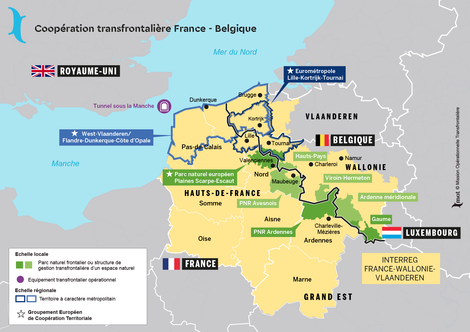Border: France Belgium
Date(s) of establishment: 1713 (Treaty of Utrecht)Length of border: 620 km
Regions concerned: France: Regions – Nord-Pas-de-Calais, Picardie, Champagne-Ardenne, Lorraine; Departments – Nord, Aisne, Ardennes, Meuse, Meurthe-et-Moselle
Belgium: Regions – Wallonia, Flanders; Provinces – Hainaut, Namur, West Flanders
European programme(s):
- Interreg VA - France-Wallonie-Vlaanderen:
Website of the programme
The programme on the Inforegio website - Interreg VA - 2 Seas:
Website of the programme
The programme on the Inforegio website - Interreg VA - Grande Région:
Website of the programme
The programme on the Inforegio website
Overview
A “melting pot-border”1 since its creation in 1713, the frontier between France and Belgium has always been an area where there has been movement and contact. Characterised by a very dense network of urban settlements as well as by major river, road and rail networks, its territories provide a geographical context that is conducive to cross-border exchanges and cooperation.
The Brussels Agreement, which was signed in 2002 by the French and Belgian governments, made this cooperation official and gave it a specific legal framework. The two main cross-border conurbations, Dunkirk-Flanders-Côte d’Opale and the Lille-Kortrijk-Tournai Eurometropolis, both of which are structured as EGTC, are dynamic cross-border urban areas in which cooperation is advanced. Rural and protected natural spaces also account for a significant share of these territories and the cross-border cooperation between them is highly developed in some cases.
Cross-border cooperation at this long and varied border is highly evolved and long-standing, but its governance is relatively informal and unstructured (with a few exceptions) compared with other borders. The main specific feature of French-Belgian cross-border cooperation is the predominance of a “bottom-up” approach to governance due to the major role played by the two urban EGTC, which serve as multi-level fora for dialogue.
- Characterised by the absence of any geographical obstacle, a "melting pot-border" owes its position more to history than to geography. In this way, it is the opposite of a "rampart-border". A focus for cultural exchanges and contact, it is often associated with significant urbanisation and allows the emergence of common cultural frames of reference (language, for example) on either side of the border.
Territory projects and institutional bodies for cooperation
Institutional cooperation at the state level
French-Belgian Parliamentary Working GroupCross-border cooperation at the regional level
Greater RegionCross-border cooperation at the local level
Dunkirk-West Vlaanderen-Côte d'OpaleLille-Kortrijk-Tournai Eurometropolis
Cooperation between protected natural areas
Hainaut Cross-border Nature ParkParc naturel régional des Ardennes et Parc naturel de Viroin-Hermeton


